Space Age hieroglyphsby Roger Guillemette and Dwayne A. Day
|
| The disclosure of the “secret” STS-38 patch raises the interesting possibility that other classified shuttle mission patches may also exist. |
Although STS-38’s operational secrets were cloaked at great effort and expense, subtler clues hinted at the mission’s clandestine nature. The official mission patch for the flight (Figure 1) featured two nose-on images of a shuttle orbiter, with a white version on top and a dark version below. According to NASA’s image description, “the top orbiter …symbolizes the continuing dynamic nature of the Space Shuttle Program. The bottom orbiter, a black and white mirror image, acknowledges the thousands of unheralded individuals who work behind the scenes …this mirror image symbolizes the importance of their contributions.”
But NASA has never disclosed that there was also a secret patch designed for this mission: an emblem that had a darker border (Figure 2). Most notably, the shuttles were inverted, with the black orbiter—the classified mission—on top, and the white orbiter on the bottom. It was an inside joke by the all-military crew about the true nature of their mission.
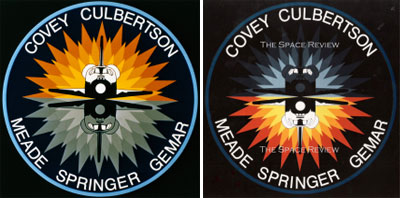 Figure 1 (left) and Figure 2 |
Many shuttle crews have created unofficial humorous patches for their missions over the years. But the disclosure of the “secret” STS-38 patch raises the interesting possibility that other classified shuttle mission patches may also exist.
There is considerable anecdotal evidence from the expendable rocket community that patches for classified space missions have long existed, often containing not only inside jokes, but also hints and clues about a rocket’s payload. It would not be too much of a stretch to presume that similar patches may have been created for other classified shuttle payloads as well.
Shedding some light
Since we wrote our initial article on patches for military space missions (see “Secrets and Signs”, The Space Review, January 7, 2008), and how they occasionally reveal details of the classified payloads, we have gathered a substantial amount of new information on a number of these patches. Although there are no secrecy-shattering revelations, these tidbits do help to fill in some of the question marks surrounding this arcane subject, as well as correct some of our preliminary guesses about the meaning of a few of these patches.
Patches for classified robotic spacecraft launches have gone largely unnoticed outside of the small community of people actually involved with a specific mission who designed, manufactured and distributed these prized souvenirs within their inner circle. Except for some publicity in 2000 about a National Reconnaissance Office radar imaging satellite known as “Lacrosse”, the subject has not drawn much attention from the press or even collectors.
However, the recent publication of Trevor Paglen’s awkwardly named book, I Could Tell You But Then You Would Have To Be Destroyed By Me, (Melville House, 2008), which primarily focuses on patches for secretive aircraft programs—particularly those at Area 51/Groom Lake—has attracted some new attention to the subject. Paglen’s book is beautifully illustrated and a lot of fun, and was prominently featured in a full-color, full-page spread in The New York Times, television’s “The Colbert Report”, and a segment on National Public Radio; however, it contains relatively little information on spacecraft patches. As we demonstrated in our previous article, there are numerous classified spacecraft and launch patches that have received little attention or interpretation.
Dragons above
Images of dragons have appeared in at least four recent patches for classified spacecraft launches. Quite often, these patches for classified satellite programs feature stars that apparently correspond to the number of spacecraft of that general type launched over the years. Thus, the eight stars in a 2003 patch associated with the launch of a signals intelligence satellite corresponds with the eight large satellites of that type launched over several decades of operation.
As we noted in our first article, a dragon patch with four stars was a bit of an enigma. It had not been definitively connected with any specific launch. The four stars would appear to correspond to the fourth satellite of that type launched in 1978. Yet a recently acquired version of this patch is unblemished and pristine, with crisp, bold colors apparently the result of modern computerized embroidery. It seemed highly unlikely that this patch was knocking around for thirty years and, as you will soon see, it was associated with a much more recent mission than we originally surmised.
| The dragons’ wings form the shape of a parabolic dish, a clear reference to the large dish-shaped antennae prominently featured on these signals intelligence spacecraft. |
We were recently allowed access to a nearly-complete collection of Titan IV patches which listed the missions each payload patch was associated with. It turns out that this dragon patch actually was the spacecraft patch for a 1998 Titan IV launch of a large signals intelligence satellite. This collection of Titan IV patches allows us to correct the record and look for any patterns.
The first dragon patch is for the satellite launched on a Titan IV (mission K-23) on May 15, 1995 from Cape Canaveral. This rocket had a 26.2-meter-long (86-foot-long) payload shroud and was launched to a geosynchronous orbit. Independent observers believe that it was the first of a new class of large signals intelligence satellites they designated “Advanced Orion”. The patch for this mission (Figure 3) had three stars, indicating that it was possibly the third satellite of that general class launched into space. In fact, two large geosynchronous signals intelligence satellites were reportedly launched by the space shuttle during the 1980s, so this may have been a follow-on spacecraft to those earlier launches.
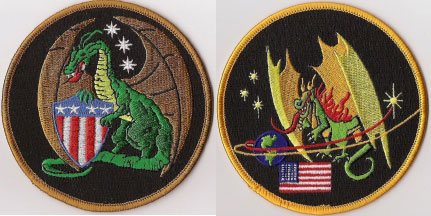 Figure 3 (left) and Figure 4 |
On May 8, 1998, the Air Force launched another Titan IV (mission B-25) with characteristics similar to the May 1995 Advanced Orion launch. The patch for the satellite (Figure 4) on this launch is similar to its predecessor (figure 3). It contains four stars, plus the trail of something else—a higher altitude payload?—leaving the frame.
On September 9, 2003, the Air Force launched another Titan IV (mission B-36) that shared characteristics with the two previous Advanced Orion launches. Once again, the patch for this mission featured a dragon, although it did not include stars around the Earth (Figure 5). It did, however, feature a diamond in the clutches of the dragon’s tail. Could this signify that this was the capstone launch for the program? Perhaps the last payload of that type launched?
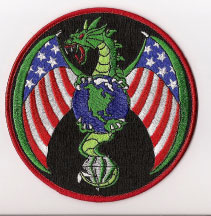 Figure 5 |
One thing that is noticeable about all three patches, and which is especially stark when looking at actual versions of both the first and second dragon patches, is that the dragons’ wings form the shape of a parabolic dish, a clear reference to the large dish-shaped antennae prominently featured on these signals intelligence spacecraft.
Although the dragon motif is consistent with other patterns observed about these satellites, such as the orbits they flew in and the size of the Titan IV payload shrouds, it is now clear that the dragon, or a similar reptile motif, shows up in other patches for other high-altitude signals intelligence satellites.
For instance, on July 10, 1995, the Air Force launched a Titan IV (mission K-19) from Cape Canaveral equipped with an 86-foot payload shroud, like the other “dragon patch” missions. However, this payload did not head for geosynchronous orbit; instead, it arced up the US East Coast toward a highly elliptical high inclination orbit. Independent observers declared that this was a class of signals intelligence satellites named “Trumpet”. The patch for this mission (Figure 6) featured two dragons hovering over the Earth, and also eight stars. The golden-shaped “wings” on the dragons are the clearest indication of all the patches hinting at the presence of large parabolic dish antennae (which also happen to be covered with a gold alloy).
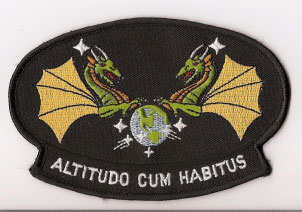 Figure 6 |
On November 8, 1997, the Air Force launched yet another Titan IV (mission A-17) with characteristics similar to the previous Trumpet mission. This mission patch (Figure 7) featured three cobras wrapped around the Earth. It also featured eleven stars. Notably, the cobras’ bodies and tails seem to indicate both equatorial and high inclination orbits. The Latin phrase—Nunquam Ante Numquam Iteram—cryptically translates to “Never before, never again.”
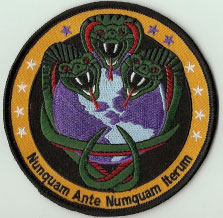 Figure 7 |
The Trumpet program was apparently followed by a new program featuring somewhat smaller satellites but operating in similar orbits. ĘThey continued the reptile motif with the launch of an Atlas V rocket on NRO launch L-28 on March 13, 2008 from Vandenberg Air Force Base. ĘThe patch associated with this launch (figure 8) shows Earth in the claws of what appears to be a reptilian hand. ĘThe design echoes the posters for the 2005 movie War of the Worlds. (Authors’ correction, 8/28/08: It was brought to our attention that the “reptilian hand” gripping the Earth in figure 8 is, in fact, an eagle’s claw, representative of the bald eagle depicted on the NROL-28 mission patch, now included as Figure 8a).
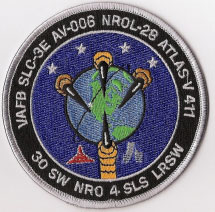 Figure 8 |
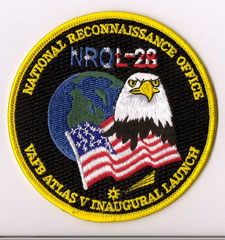 Figure 8a |
Notably, the patch features four stars, although what they refer to is still unknown.
The large number of dragon patches or patches with a reptilian motif hints that this is not only a symbol for a specific type (or class) of satellite, but perhaps for the department within the National Reconnaissance Office that manages these payloads.
There remains one additional dragon patch (Figure 9) that we have so far not been able to identify with a specific launch.
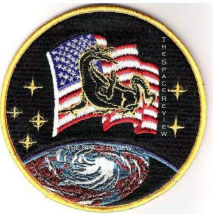 Figure 9 |
| Whereas previously it was possible to obtain many of these patches on eBay for perhaps $5–20 apiece, certain patches (those most prominently featured in Paglen’s book) suddenly were commanding prices of $60–90! |
The patch appears to be an older type, looking like other military patches produced in the 1970s and 1980s, before improvements in patch manufacturing. The six stars clearly symbolize something (notably, four of them are circled, possibly indicating satellites that were no longer active). This patch is unique as it has yet to be offered for sale on eBay.
Speaking of eBay, Paglen’s book has apparently had an interesting effect on the trade of patches for classified military programs. Initially, it drove the price for some of these patches through the roof. Whereas previously it was possible to obtain many of these patches on eBay for perhaps $5–20 apiece, certain patches (those most prominently featured in the book) suddenly were commanding prices of $60–90! Very quickly, entrepreneurs recognized a golden opportunity and began reproducing the patches in the book and offering them for sale, noting that they were the result of the book (as opposed to originals). The price of these copies is significantly lower, making it possible for anybody who has a few extra bucks to spare in a tightening economy to purchase them. The quality of most of the patches is top notch, a testament to the fact that embroidered patches are now produced in much the same way as a color photocopy, with digital sewing machines instead of laser printers.